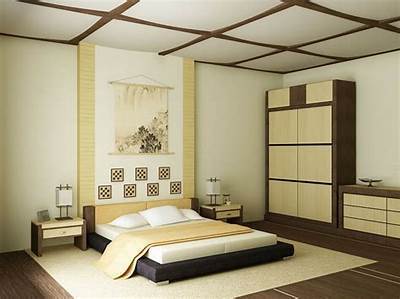Japanese Bedroom Decor: A Guide to Tranquility and Simplicity
Japanese bedroom design emphasizes minimalism, functionality, and a connection with nature. It's about creating a peaceful sanctuary where you can relax and recharge, free from clutter and distractions. This style is more than just aesthetics; it's a philosophy that prioritizes serenity and mindful living.
Core Principles of Japanese Bedroom Design
Several key principles guide the creation of a serene Japanese-style bedroom:
1. Minimalism: Less is More
The cornerstone of Japanese design is minimalism. Avoid overcrowding the room with furniture and accessories. Choose only essential pieces, focusing on quality over quantity. Every item should have a purpose and contribute to the overall sense of calm.
2. Natural Materials: Embracing Nature's Beauty
Natural materials like wood, bamboo, paper, and cotton are central to Japanese aesthetics. These materials bring warmth, texture, and a connection to nature into the space. Think natural wood floors, bamboo blinds ( sudare ), and cotton bedding.
3. Natural Light and Airflow: Connecting with the Outdoors
Maximize natural light by using sheer curtains or blinds that allow sunlight to filter gently into the room. Good airflow is also crucial; ensure adequate ventilation to create a fresh and airy atmosphere. Consider using shoji screens to diffuse light and create a sense of privacy.
4. Neutral Color Palette: Creating a Sense of Calm
A neutral color palette featuring earthy tones like beige, cream, gray, and brown is typical of Japanese design. These colors create a calming and peaceful ambiance. Accents of black or deep greens can be used sparingly to add depth and contrast.
5. Low-Profile Furniture: Maintaining a Sense of Space
Low-profile furniture, such as low beds (often a futon mattress on the floor), keeps the room feeling spacious and uncluttered. Avoid bulky furniture that dominates the room.
Key Elements of Japanese Bedroom Design
1. The Bed: The Focal Point
The bed is often the focal point of a Japanese-style bedroom. A low platform bed, a futon laid on a tatami mat, or even a simple mattress on the floor are common choices. Keep the bedding simple and clean, often featuring natural materials like cotton or linen.
2. Storage Solutions: Maintaining Minimalism
Clever storage solutions are essential in a minimalist design. Built-in closets, drawers under the bed, or even decorative chests can help keep the space organized and clutter-free. Utilize vertical space effectively.
3. Lighting: Setting the Mood
Lighting plays a crucial role in creating the desired atmosphere. Use a combination of ambient, task, and accent lighting. Paper lanterns, simple pendant lights, or floor lamps can provide soft, diffused light, enhancing the sense of calm.
4. Artwork and Accessories: Adding Subtlety
Artwork and accessories should be minimal and carefully chosen. A few pieces of calligraphy, a simple ikebana arrangement, or a nature-inspired print can add subtle visual interest without overwhelming the space. Avoid clutter; quality over quantity is key.
5. Plants: Bringing the Outdoors In
Adding a few carefully selected plants can enhance the connection to nature. Bonsai trees, bamboo plants, or other low-maintenance plants can add a touch of life and serenity to the space. Remember to maintain a balance to avoid creating clutter.
Creating Your Japanese-Inspired Bedroom
Transforming your bedroom into a tranquil Japanese-inspired sanctuary is achievable with careful planning and attention to detail. Start by decluttering and removing unnecessary items. Then, incorporate the key elements discussed above, focusing on natural materials, a neutral palette, and minimalist furniture. Consider these steps:
1. Declutter and Simplify:
Begin by removing any items you don't need or use. This will create a sense of spaciousness and calm. Keep only essential items, and consider storing others away neatly.
2. Choose a Neutral Color Palette:
Select a calming neutral color palette for your walls, floors, and bedding. Earth tones are perfect for creating a serene atmosphere. Consider using natural materials for your flooring, such as bamboo or wood.
3. Incorporate Natural Materials:
Use natural materials like wood, bamboo, cotton, and linen in your bedding, furniture, and accessories. These materials bring warmth, texture, and a sense of connection to the natural world.
4. Select Minimalist Furniture:
Opt for minimalist furniture with clean lines and simple designs. Low-profile furniture will help to create a sense of spaciousness. Consider a low platform bed or a futon.
5. Add Subtle Accents:
Add subtle accents with carefully chosen artwork, plants, and accessories. A few well-placed items can enhance the overall aesthetic without overwhelming the space. Keep it simple and uncluttered.
6. Maximize Natural Light:
Maximize natural light by using sheer curtains or blinds. This will help to create a bright and airy atmosphere. Consider using shoji screens to diffuse light and create a sense of privacy.
By carefully considering these elements, you can create a Japanese-inspired bedroom that is both beautiful and functional, offering a peaceful retreat from the stresses of daily life. Remember that this style is about creating a space that promotes tranquility and mindfulness – a true sanctuary for rest and rejuvenation.


この記事へのコメント